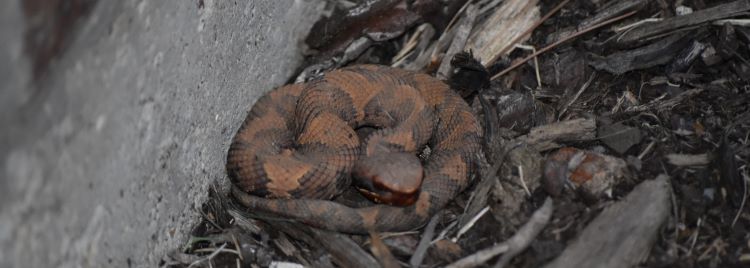
So, you’ve decided to get your yard in shape. Maybe that means clearing out the junk that’s collected under your deck over the years or finally emptying out a shed. Maybe you need to tackle overgrown bushes, a pile of old boards, or several old appliances that’ve been rusting in place.
Before you pull on your work gloves, however, make sure you know what you might find hiding in those piles of junk or vegetation. Snakes aren’t just found in wild places; they are in urban neighborhoods, too. And most snakes are “good” snakes—they aren’t going to hurt you if you get bitten. However, The San Antonio area is home to four venomous snakes that you’ll want to watch out for: coral snakes, rattlesnakes, copperheads, and cottonmouths.
As junk removal specialists, our team at Space Makers Junk Removal has encountered snakes on jobs, and we want to share how to recognize the dangerous ones and what to do if you come across one.
CORAL SNAKES
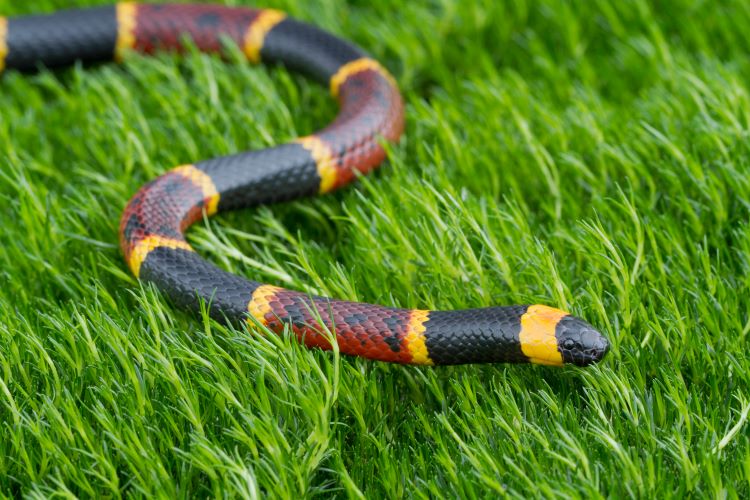
Maybe you’ve heard the rhyme, “Red and black, okay Jack; red and yellow, kill a fellow.” That saying helps you remember how to tell a dangerous coral snake from other snakes with black, red, and yellow bands, like the harmless Texas scarlet snake. Texas coral snakes have RED AND YELLOW BANDS THAT TOUCH.
WHERE YOU MIGHT FIND CORAL SNAKES
Coral snakes are mostly nocturnal and like to hang out under leaf litter, logs, and rocks. You’ll find them in wet places—rivers, creeks, streams—and in places like greenbelts, parks, and gardens. And yes, backyards, too. They hunt other snakes, rodents, and reptiles to eat.
CORAL SNAKE BITES
Coral snake venom contains a powerful neurotoxin (like a cobra’s), which means it can cause paralysis in severe cases. A bite can cause nausea, vomiting, slurred speech, muscle twitches, and double vision as well. Victims of a coral snake bite need antivenin ASAP.
WHAT TO DO IF YOU SEE A CORAL SNAKE
Do not pick up a coral snake! They may seem docile, but they’ll bite if threatened. Move away from the snake and let it get away from you. If you need the snake removed, call a professional snake removal service.
RATTLESNAKES
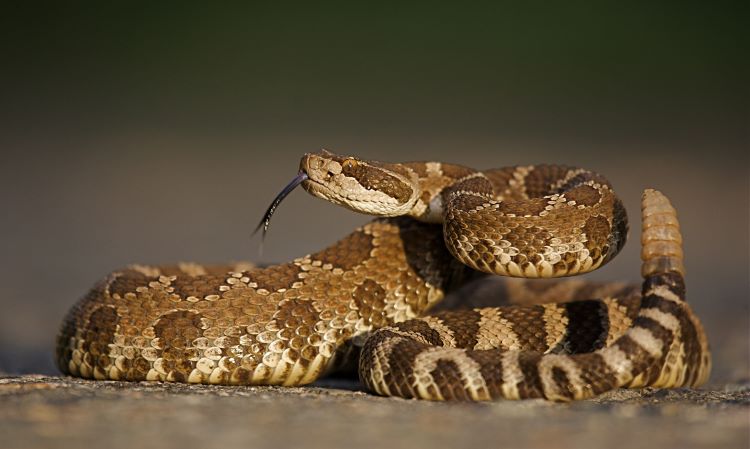
The western diamondback rattlesnake is another venomous snake you’ll want to watch out for. These rattlesnakes are brown-gray in color, with hexagonal- or diamond-shaped blotches on the back. Western diamondbacks have a triangular head, as well as black and white rings on the tail. On the tip of its tail is the distinctive rattle that it shakes when it feels threatened. Diamondbacks like to eat mice, rats, and other small mammals.
WHERE YOU'RE LIKELY TO SEE RATTLESNAKES
Like humans, rattlesnakes seek shade when it’s hot. They’ll curl up under rock ledges, fallen logs, wood piles, and rocks to keep cool on a summer day, so use caution when walking near these kinds of areas in your yard. Never reach into a hole without first checking for a snake. They love to hide out in animal burrows. On cold days, they’ll seek warm spots in the sun—on logs, ledges, rocks, roads.
RATTLESNAKE BITES
Rattlesnake bites need to be treated ASAP, or they can be fatal to humans. Rattlesnake venom acts fast, and you need to get help within half an hour if possible. The venom contains hemotoxins that prevent blood clotting, and a bite will cause tissue damage, internal bleeding, nausea, vomiting, blurred vision, breathing difficulty, and other symptoms.
WHAT TO DO IF YOU SEE A RATTLESNAKE
Most experts agree that if you hear that distinctive rattle, freeze. Look around for the snake and, if it's not too close, back slowly until you’re at least five feet away, because rattlesnakes can strike as far as two-thirds of their body length. That means rattlesnake that’s six feet long can strike up to four feet away! If you stay still and calm, in most cases, the snake will simply leave the area and you’ll be free to move about again. Don’t chuck rocks at it or try to pick it up with a stick. Call a professional snake removal service to remove a rattlesnake from your yard.
COPPERHEADS
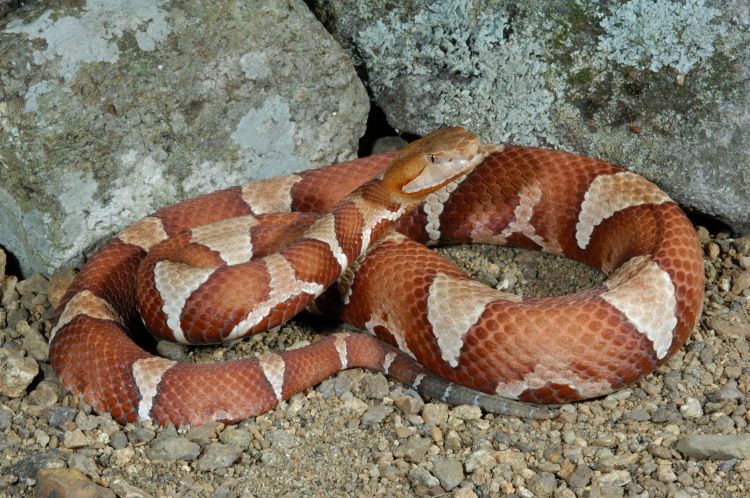
Copperheads get their name from—you guessed it—their reddish heads. They are generally light in color, with dark brown or reddish-brown hourglass-shaped markings on their bodies, on top of a lighter color (light brown, tan, or pink). Their heads are mostly arrow shaped.
WHERE YOU'RE LIKELY TO SEE COPPERHEADS
They prefer rocky, wooded areas, but you can also find them near water sources like streams or ponds. They do well in urban settings, and can be found hiding beneath things like logs, wood piles, stacks of boards, flat rocks, and sheet metal.
COPPERHEAD BITES
According to Texas Parks and Wildlife, copperhead bites aren’t usually fatal because copperheads have short fangs and very little venom. However, a copperhead bite is very painful and can cause tissue damage.
WHAT TO DO IF YOU SEE A COPPERHEAD
If you come across a copperhead, stay calm, be still, and let it make its getaway. To remove it from your property, call a professional snake removal service.
COTTONMOUTHS
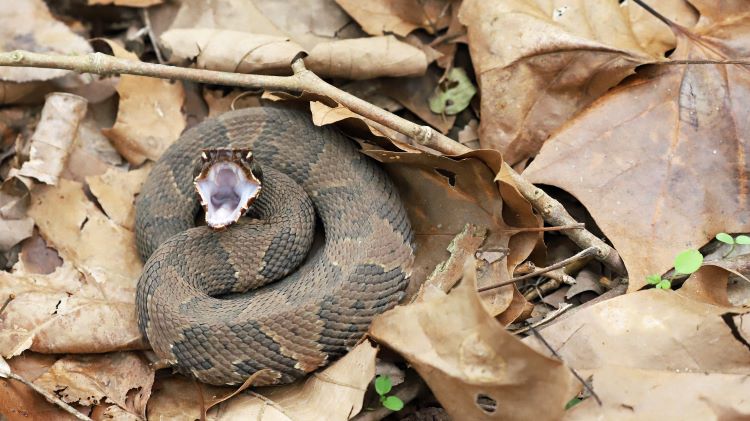
Cottonmouths—also called water moccasins—have distinctive white tissue inside their mouths. When threatened, they’ll open their mouths to display this soft, cotton-colored tissue. Their heads are thick and wider than their necks. As for coloring, cottonmouths can be anywhere from solid black to dark brown or olive.
WHERE YOU'RE LIKELY TO ENCOUNTER A COTTONMOUTH
Cottonmouths like water, so look for them near swampy areas, ponds, streams, and other waterways. They prey on fish, frogs, lizards, birds, and small mammals.
COTTONMOUTH BITES
While humans rarely get bitten by cottonmouths, a bite from a cottonmouth can be deadly to humans. Cottonmouth venom contains hemotoxins that prevent blood from clotting, so as the venom spreads, a person can bleed profusely internally and externally. If not treated, bites can lead to muscle loss and gangrene.
WHAT TO DO IF YOU SEE A COTTONMOUTH
Be cautious as you tramp around the edges of water features like ponds or creeks. Most bites occur when someone steps on a cottonmouth and surprises it. If you get close to a cottonmouth, it will coil into a striking posture (like a rattlesnake does), shake its tail, and open that white-lined mouth. You may even smell a bad odor, and it may hiss.
Back away immediately. Do not try to handle a cottonmouth. Instead, call a snake removal professional to come remove the cottonmouth.
IF YOU GET BITTEN BY A VENOMOUS SNAKE
If you’re bitten by a venomous snake, immediate action is essential. The CDC recommends these steps:
- Call 911 or have someone drive you to a hospital ASAP, if it’s close. (Don’t try to drive yourself because you might pass out.)
- If you can, snap a photo of the snake so doctors will know exactly what bit you. If you can’t take a picture, try to remember what the snake looked like: size, coloring, shape of head.
- Use a pen to draw a circle around the edge of where the swelling is, and write the time beside that edge. That way, doctors will know how far and how quickly the swelling has progressed by the time you get to the hospital.
- Stay calm and as still as possible.
- Wash the area with soap and water and cover it with something clean, like a bandage, if you have one.
- Try to keep the bitten area lower than your heart.
- Take off any rings, watches, or other jewelry on the affected limb before swelling makes them too tight to remove.
- Never try to handle the snake, even if it’s dead.
- Don’t wait for symptoms to show up—get help immediately. The sooner you get antivenin, the better your outcome will be.
WHAT YOU SHOULD NOT DO TO A SNAKEBITE
There are lots of myths and misinformation out there that can actually make a snakebite worse. Make sure you know what NOT to do.
- Don’t apply a tourniquet (Doing so can concentrate the venom in one limb, causing long-term damage. Also, tourniquets can make treatment more complex for doctors at the hospital.)
- Don’t cut the bite open with a knife and try to push or suck out the venom (Doing so can introduce germs into the wound and increase the chances for infection. Also, you could ingest some of the venom by sucking on the wound.)
- Don’t put ice on a snakebite (Doing this can make blood vessels constrict, causing tissue damage.)
- Don’t drink alcohol or caffeine (these can speed up the effects of the venom)
- Don’t take any pain relievers (Taking a pain reliever like ibuprofen or aspirin could prevent your blood from clotting.)
HOW TO PREVENT AN ENCOUNTER
- Be extra watchful for snakes after rain events and flooding.
- Keep your lawn mowed. Snakes like tall grass and weeds.
- Keep your garage and sheds decluttered and clean. Don’t give snakes a place to hide.
- Remove debris where snakes could hide, such as large logs or piles of lumber, rocks, or bricks.
- Use caution when reaching into debris piles, holes, under decks or sheds, and beneath rock outcroppings.
- Remove piles of junk like old toys, defunct appliances, broken lawn furniture.
- Don’t go barefoot. If you can, wear boots or snake boots.
- Take steps to control pests like mice on your property, since they’ll attract snakes.
- Teach children to recognize venomous snakes and not to touch them; tell them to go tell an adult if they see any snake.
- Make a “snake bite” plan so you know what to do if you or someone you know is bitten. Make sure everyone in your family knows how to dial 911 or knows where the nearest hospitals are.
SNAKE SENSE IN GENERAL
Snakes are not “out to get you.” And most snakes are not venomous to humans. They just want a good meal, so they’re in your yard because they’re after something to eat. They’re actually doing a job for you, getting rid of mice and rats, which carry diseases, fleas, and ticks. Texas Parks and Wildlife advises anyone who sees a snake they can’t identify to simply be still and let the snake slither off on its own. If you can’t do that, then slowly back away. Makes sense, doesn’t it?
CALL SPACE MAKERS TO KEEP YOUR AREAS FREE OF PLACES SNAKES CAN HIDE
We do garage cleanouts, shed cleanouts and removal, and debris removal. Contact us today and we’ll haul off the junk that might tempt a snake to set up shop on your property.

